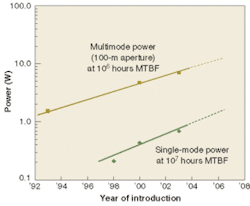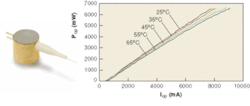Distributed multimode architectures deliver low-cost power and reliability
Highly reliable, high-power single-emitter laser chips and packaging have powerful manifestations when deployed in large ensembles. A modest redundancy means that pump power can be maintained with high confidence over extended periods of time.
Several diode-pumped laser architectures, particularly ytterbium (Yb)-based fiber and thin-disk lasers, are emerging as alternatives to traditional flashlamp-pumped Nd:YAG lasers for industrial applications ranging in power from a few watts to a few kilowatts. Diode-pumped lasers (DPLs) offer numerous advantages over flashlamp-pumped Nd:YAGs, including better beam quality, lower power consumption, a smaller footprint, and reduced downtime and maintenance costs. The advancement of DPLs has been hindered, however, by the lack of diode-pumped lasers that are both reliable and affordable.
New single-emitter laser-diode technology is suitable for high-power industrial DPLs. Progress in single-emitter laser diodes (SELs) makes them an alternative to 1-cm-wide multi-emitter laser-diode-array (bar) tech-nology. The outstanding reliability of SELs enables the deployment of novel distributed pump architectures that promise to deliver both superior DPL system reliability and low total cost of ownership.
Single-emitter-diode reliability
Rigorous cost-effective burn-in screening and accurate reliability models allow SELs to meet the most demanding reliability specifications. Rigorous burn-in is achieved by operating devices at significantly elevated ambient-temperature, optical-power, and drive-current levels, thereby accelerating the failure of any less-robust device population. Typical acceleration factors 150 times above the rated operating condition allow the complete removal of infant failures within only a few hours. In contrast, bars operate very close to their absolute thermal limit, so the individual laser stripes that make up the array can only be lightly screened at a three to four times acceleration. Therefore, the burn-in time required for the complete removal of infant failures within a bar is impractical.
For more than a decade, every serious 900- to 1000-nm (or "9xx-nm") SEL technology exhibited reliability that is accurately modeled by the equation:
FailureRate(Tj, I, P) ∝ e-EA/kBTjImPn
where Tj is the laser-diode junction temperature, I and P are the drive current and optical output power of the diode, respectively, and kB is the Boltzmann constant. The key enabler for modeling SEL reliability analytically by this equation is the dominance of a single bulk-failure mode, which is random in time. Device populations suffering from multiple concurrent failure modes or time-dependent effects like infant failures, wear-out degradation, or catastrophic optical mirror damage are much more challenging to model. The Arrhenius factor (EA), the exponents of current (m) and power acceleration (n), and the proportionality constant of this equation are fit by performing a multicell life test, which measures device-failure rates across various accelerated temperature, drive-current, and optical-output-power conditions.
The high acceleration levels attainable in SELs permit statistically relevant data to be collected on a modest sample size over the course of several months. Multicell testing of bars is less fruitful at the low attainable acceleration levels because only a small parameter space can be explored and proportionally more device hours are needed to generate statistically relevant conclusions. Furthermore, the predominant bar failure mechanisms are either time dependent (for example, wear-out and infant failures) or externally induced (microchannel cooler reliability), which greatly complicate the generation of an analytical reliability model.
One such multicell life test was performed on the current 9xx-nm, 100-µm-emitting aperture, multimode SEL generation.1 Roughly 200 diodes from four distinct epitaxial wafer runs were tested at overstress conditions ranging from Tj = 107°C to 145°C, P = 5.2 to 9.5 W, and I = 7 to 12 A. The multicell test has run more than 3000 hours (accumulating more than 500,000 total device hours). Preliminary modeling yields a conservative estimate of greater than 500,000-h mean time between chip failures (MTBF) for a 6.5-W/35°C–rated operating condition. The ability to apply the above equation with confidence permits users to deploy SELs at whatever ambient temperature and output power meets their own system-reliability targets.
High-power fiber-coupled single-emitters
High investment, originally driven by the telecom boom, has increased telecom-grade, single-spatial-mode 980-nm laser-diode power by more than 25% per year, reaching 700 mW (see Fig. 1). This corresponds to an astounding ex-facet optical-power density of 35 MW/cm2. Lower investment levels drove multimode SEL performance forward by a still-impressive 17% per year. We believe this pace of technical progress will continue, and in the case of multimode diodes, even accelerate, as rapid growth of Yb-based DPLs drives increased investment. Manufacturing improvements, made possible by the combined volumes of telecom and industrial pump lasers, allow 9xx-nm SEL unit pricing to decline even while output power increases. In terms of the key dollars-per-watt pump-laser metric, the cost of SELs has fallen by more than 50% every two years, exceeding even Moore's Law.
The corresponding data for bar technology date back to 1998, when a 1-cm bar with a 50% fill factor of 100- to 200-µm emitter apertures produced 20 W. Such a bar is rated at 50 W today, a 17% annual rate of progress. During this period, predicted bar lifetime has surpassed 10,000-h MTBF and further innovations like hard-solder mounting should continue to improve bar reliability. The unit price of a bar on submount has fallen by about 2.5 times since 1998, which, combined with performance improvements, has generated an average annual decline in dollars per watt of about 80% of the SEL rate. The shrinking dollars-per-watt value gap between the pump technologies has led to increased consideration of SEL technology for 100-W to 10-kW–class DPLs.
Fiber-coupled single-emitter packaging
A comprehensive understanding of chip reliability is of little use unless its packaging meets similarly high standards. The L3 platform selected for current and future generations of pigtailed multimode SELs preserves a standard external form factor deployed since the mid-1990s in diverse industrial-laser applications (see Fig. 2). Proven telecom technology within ensures high reliability at fiber-coupled powers of 5 W and above.
The critical elements of the L3 package design are based on proven telecom architectures, including the optical train, fiber alignment, snout seal, and internal-component assembly processes. The platform delivers a low thermal resistance of 4°C/W from the laser-diode junction to the external heat sink, an average 9xx-nm coupling efficiency of greater than 80% into a 0.2 numerical aperture, and reliable continuous-wave (CW) output power exceeding 5 W. Single-mode 980-nm pump modules incorporating this basic technology have more than 2 million hours MTBF proven field reliability with thousands of hours of demonstrated high-temperature (for example, 85°C) stability of the critical fiber-alignment joint. The package component of L3 reliability is estimated to be at least 1 million hours MTBF based on its similarity to the telecom package, less critical alignment tolerances for multimode coupling, and extensive independent qualification data. When the combined reliability of the laser diode and package are considered, the L3 is expected to deliver 5 W of CW or pulsed 9xx-nm fiber-coupled power with 400,000-h MTBF at a 35°C case temperature.
Ensembles
The most critical industrial applications demand telecom-like laser reliability, although those requirements are formulated into other metrics. Lasers offering greater than 99% uptime, predictable service cycles, and low total cost of ownership (including service and material costs, electricity and cooling, and floor-space requirements alongside the initial capital investment) are actively sought to replace existing lamp-pumped Nd:YAG infrastructure.
We propose an architecture of discrete SELs, connected in electrical series, whose output is combined through commercially available multimode fiber combiners or bundles.2 Such an ensemble is modeled using MTBF as an input for m = 40 pumps, each delivering 5-W end-of-life power, with n = 4 allowed failures (see Fig. 3).
For durations less than (nMBTF)/(2m), the probability of ensemble survival is typically greater than 95%. In the case of 400,000-h-MTBF L3 lasers, the certainty of the ensemble delivering 180-W rated power (36 lasers at 5-W end-of-life) over 12,000 hours of continuous operation exceeds 99%. Less than 10% of fiber-combined ensemble units would require service during the first three years of continuous operation. Because their reliability is well understood as functions of temperature, power, and redundancy, DPL designers using SEL ensembles are free to achieve their system-level reliability objectives by adjusting these three independent variables. Ensembles composed of less-reliable (for example, 50- to 100-kh MTBF) individual devices cannot deliver similarly high system survivability at an affordable level of pump redundancy. The full advantages of ensemble architectures are only affordably realized using highly reliable individual components.
Ensembles of SELs have important advantages over bar-pump architectures. Simple (10-A, 100-V) power supplies and low-cost, closed-cycle cooling are used. The user interface consists of two electrical pins and a single connectorized or bare fiber output. Ensemble degradation is gradual, corresponding to individual laser failures, permitting remote monitoring and a high degree of service predictability. When a laser diode fails, it remains a diode with unchanged electrical properties, so the ensemble is undisturbed. When an ensemble reaches the assigned end-of-life condition, the long MTBF of the surviving lasers means only the few failed laser diodes are replaced during refurbishment, greatly reducing the 5- to 15-year cost of ownership. Current ensembles comprise up to 61 lasers in a single fiber-combined unit, but the high degree of granularity means users can deploy as few diodes as necessary to meet power and reliability targets. Alternatively, further combination of arbitrarily many ensembles can attain kilowatts of pump power. The rapid dollars-per-watt cost reduction of single-emitter power suggests such ensemble pumping will be widely adopted in industrial-laser applications.
ACKNOWLEDGMENTS
The authors thank their colleagues Dick Duesterburg, Andre Wong, and Lei Xu for their contributions to this article.
TOBY STRITE is business-development manager, SILKE PFLUEGER is product-line manager, VICTOR ROSSIN and ERIK ZUCKER are chip-development managers, KUOCHOU TAI is package-development engineer, and ED WOLAK is package-development manager at JDS Uniphase, 1768 Automation Parkway, San Jose, CA 95131; e-mail: [email protected].
REFERENCES
- V. Rossin et al., SPIE proc. 5336-27, Photonics West, San Jose, CA (Jan. 27, 2004).
- Ed Wolak et al, SPIE proc. 5336-17, Photonics West, San Jose, CA (Jan. 26, 2004).



